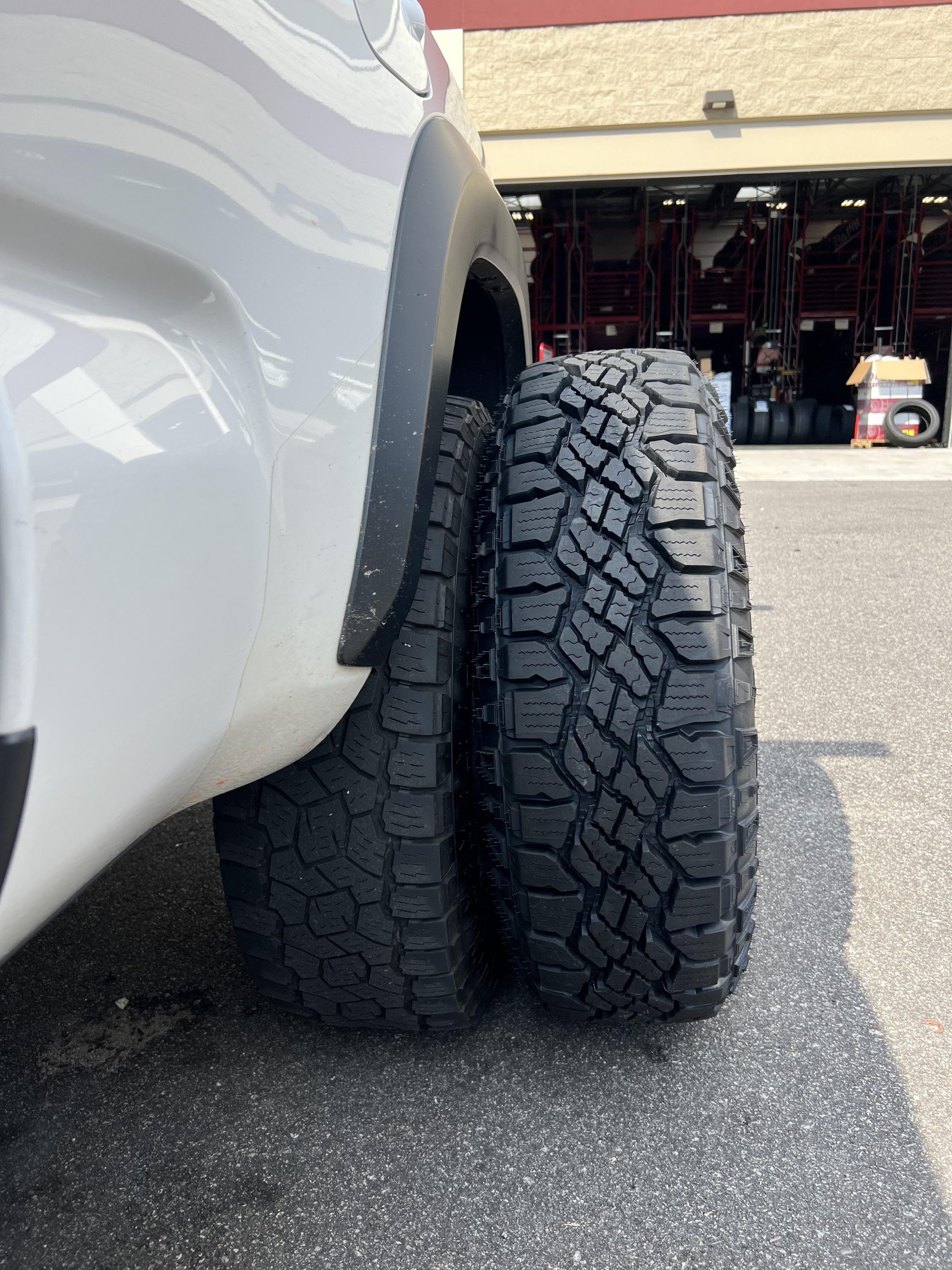255 75R17 Vs 265 70R17: Which Tire Size is Right for You?
255 75r17 and 265 70r17 are tires with similar height and width but slight variations in their aspect ratio and width. Choosing the right tire size is crucial for your car’s performance, safety, and fuel efficiency.
While both tire sizes may fit your vehicle, it’s crucial to understand their differences to select the most suitable option. A tire with a higher aspect ratio provides a smoother and more comfortable ride, while a wider tire offers better stability and handling.
In this article, I will explore in detail the difference between 255 75r17 Vs 265 70r17, their pros and cons, and how to choose the right one for your needs.
Understanding Tire Sizing
When it comes to purchasing new tires for your vehicle, size is an important factor to consider. The size of your tires affects your car’s performance and safety on the road. This section’ll explain tire sizing, the importance of choosing the correct tire size, and how to read tire size markings.
Explanation Of Tire Sizing
Tire sizing can be confusing if you’re unfamiliar with the numbers and letters on the sidewall of your tire. However, it becomes much simpler once you understand how to read the markings. The numbers on the tire indicate its size and specifications.
Here’s what each number and letter means:
- 255: This number indicates the tread width of the tire in millimeters.
- 75: This number represents the aspect ratio, the height of the tire’s sidewall as a percentage of its width.
- R: This indicates that the tire is a radial tire.
- 17: This is the diameter of the wheel rim in inches.
Importance Of Choosing The Correct Tire Size
Selecting the right tire size for your vehicle is crucial. Getting the wrong size can negatively impact your car’s performance, including handling, fuel efficiency, and even braking. Using the wrong tire size can also be dangerous and increase the risk of accidents.
Thus, it’s essential to ensure you’re fitting your vehicle’s correct tire size.
How To Read Tire Size Markings
As we mentioned earlier, understanding tire size markings is essential to choose the correct size for your vehicle. Here’s how to read the markings:
- Look for the numbers on the sidewall of your tire.
- The first number you see is the tread width in millimeters.
- The second number is the aspect ratio, which represents the height of the sidewall as a percentage of the tread width.
- The letter ‘r’ comes next, representing the tire type, which is radial for most vehicles.
- The final number is the diameter of the wheel in inches.
By understanding tire sizing, you can confidently choose the correct tire size for your vehicle, improving overall performance and ensuring your safety on the road.
Comparing 255 75R17 And 265 70R17
Overview Of Each Tire Size
Regarding the debate between 255 75r17 and 265 70r17 tire sizes, it’s important to understand the basic characteristics of each.
- 255 75r17:
- Height: 32.1 inches
- Width: 10 inches
- Tread depth: 13.2/32 inches
- Load capacity: 2,623 lbs
- Speed rating: Q (99 mph)
- 265 70r17:
- Height: 31.6 inches
- Width: 10.4 inches
- Tread depth: 13.5/32 inches
- Load capacity: 2,756 lbs
- Speed rating: T (118 mph)
Comparison Of Factors Such As Tire Height, Width, Tread Depth, Load Capacity, And Speed Rating
The difference in size between 255 75r17 and 265 70r17 may not seem significant, but it can have a noticeable effect on performance. Let’s look at the key factors to compare these tires.
- Tire height:
The height of a tire affects the overall diameter and clearance. While the difference between these two sizes is only half an inch, 265 70r17 is slightly shorter.
- Tire width:
The width of a tire affects the contact patch and the handling. 265 70r17 is wider than 255 75r17.
- Tread depth:
The tread depth affects traction and wear. 255 75r17 and 265 70r17 have a similar tread depth, but the latter has a slightly more significant depth.
- Load capacity:
Load capacity is the maximum amount of weight that a tire can support. While both sizes have a high load capacity, 265 70r17 can handle a slightly heavier load than 255 75r17.
- Speed rating:
The speed rating means the maximum speed that a tire can handle. While both sizes have acceptable speed ratings, 265 70r17 has a higher rating than 255 75r17.
Pros And Cons Of Each Tire Size
When it comes to choosing between 255 75r17 and 265 70r17, here are some benefits and drawbacks to consider:
- 255 75r17:
- Pros:
- Larger height provides more clearance for off-road driving
- Narrow width can offer better stability on paved roads
- Cons:
- Lower load capacity than 265 70r17
- Slower speed rating than 265 70r17
- 265 70r17:
- Pros:
- Wider width offers more stability in changing conditions
- Higher load capacity than 255 75r17
- Faster speed rating than 255 75r17
- Cons:
- Smaller height may cause clearance issues on rough terrain
Both 255 75r17 and 265 70r17 are suitable tire sizes for different purposes. It’s important to consider the vehicle, terrain, driving conditions, and individual preferences before making a final decision.
Factors To Consider When Choosing Tire Size
Choosing the right tire size for your vehicle is essential in ensuring your driving safety. Tire size affects your vehicle’s overall acceleration, braking, handling, and fuel efficiency. To help you make an informed decision between 255 75r17 vs 265 70r17 tire sizes, here are some factors to consider:
Type Of Vehicle
The type of vehicle is the first factor to consider when choosing a tire size. Different vehicles require different tire sizes depending on their weight, size, and intended use. Here are some examples:
- Suvs: Suvs generally require larger tires that can handle more weight and offer better ground clearance, making 265 70r17 tire size a better option for suvs.
- Trucks: Trucks require tires that can handle heavy loads, so 255 75r17 tire size is a better option for trucks.
- Cars: Cars typically require smaller tires that offer better fuel efficiency. Therefore, 265 70r17 tire size may not be suitable for cars.
Driving Conditions And Terrain
The driving conditions and terrain you encounter also play a vital role in determining which tire size is ideal for you. Consider the following:
- Off-road driving: If you frequently drive off-road, larger and wider tires such as 255 75r17 will support your vehicle’s weight, reduce the chances of punctures, and provide better traction on tough terrain.
- City driving: If you mainly drive on paved roads in the city, smaller tires such as 265 70r17 will provide better fuel efficiency and handling.
Desired Performance
When selecting tire size, consider your driving needs and desires, such as:
- Fuel efficiency: If you prioritize fuel efficiency over off-road capabilities and handling, go for smaller tires like 265 70r17 that offer better gas mileage.
- Off-road capabilities: If you frequently drive off-road or in harsh weather conditions, go for larger tires like 255 75r17 that will provide better traction, improved ground clearance, and optimal stability.
- Handling: If you are looking for a tire that offers better handling and cornering, smaller tires like 265 70r17 may be a better option.
Selecting the right tire size requires a comprehensive understanding of your vehicle’s type, driving needs, and conditions. This guide should help you decide between 255 75r17 vs 265 70r17 tire size based on your preferences and driving needs.
Installation And Maintenance Tips
Installation Process For Each Tire Size
The installation process for your tires will vary depending on the size you choose. Here’s a breakdown of the installation process for both tire sizes:
255 75R17
- Choose a reputable tire shop or mechanic to install your tires.
- Remove the old tires from your vehicle.
- Install the new 255 75r17 tires onto your vehicle’s wheels, making sure to align them properly.
- Tighten the lug nuts to the manufacturer’s recommended torque specifications.
- Check the air pressure of your new tires and inflate them to the recommended level.
265 70R17
- Choose a reputable tire shop or mechanic to install your tires.
- Remove the old tires from your vehicle.
- Install the new 265 70r17 tires onto your vehicle’s wheels, making sure to align them properly.
- Tighten the lug nuts to the manufacturer’s recommended torque specifications.
- Check the air pressure of your new tires and inflate them to the recommended level.
Tips For Maintaining And Extending The Life Of Your Tires
Regular maintenance is crucial for extending the life of your tires. Here are some tips:
- Check your tire pressure regularly, at least once a month. Underinflated tires can lead to premature wear and tear, while overinflated tires can reduce your vehicle’s handling and grip.
- Rotate your tires every 5,000 to 8,000 miles to ensure even wear and tear on all tires.
- Keep your tires properly aligned; misaligned tires can cause uneven wear and tear and lead to more frequent replacements.
- Avoid sudden stops and aggressive acceleration, which can cause premature wear and tear on your tires.
- Look for signs of damage, such as cracks or bulges, and replace damaged tires immediately.
Recommended Brands And Models For Each Tire Size
Choosing the right tire brand and model can significantly affect your vehicle’s performance. Here are some recommended brands and models for each tire size:
255 75R17
- Bf goodrich all-terrain t/a ko2
- Goodyear wrangler duratrac
- Michelin defender ltx m/s
265 70R17
- Bridgestone dueler a/t revo 3
- Continental terraincontact a/t
- Yokohama geolandar a/t g015
Remember, proper installation, maintenance, and the right tire choice can significantly impact the safety and performance of your vehicle. Choose wisely and take good care of your tires to ensure a smooth ride for miles to come.
Frequently Asked Questions For 255 75R17 Vs 265 70R17
What Is The Difference Between 255 75R17 And 265 70R17?
255 75r17 tire is taller, while 265 70r17 tire is wider. They have different aspect ratios.
Which Tire Is Better For Off-Roading, 255 75R17 Or 265 70R17?
255 75r17 tire provides better off-roading performance, thanks to its larger diameter and narrower width.
Can I Replace 255 75R17 With 265 70R17?
Yes, you can replace 255 75r17 with 265 70r17, but the speedometer readings and handling might be affected.
Which Tire Size Is More Fuel-Efficient, 255 75R17 Or 265 70R17?
265 70r17 tire size is more fuel-efficient because of its lower rolling resistance due to wider width.
Will Switching From 255 75R17 To 265 70R17 Affect My Vehicle’S Performance?
Yes, switching from 255 75r17 to 265 70r17 might affect your vehicle’s performance, especially if it alters oem specifications.
Conclusion
After weighing the pros and cons of both these tire models, we can conclude that it ultimately boils down to one’s personal requirements. If you prioritize better off-road performance, 255 75r17 is a better pick. It offers a larger tire sidewall, which improves stability and grip on uneven terrains.
However, if you need better traction on a wet or dry road, 265 70r17 will serve the purpose. It provides a better grip, stability, and steering response, especially in cornering. Both the tire models have their own strengths and weaknesses, so it’s vital to select the one that meets your driving needs, lifestyle, and budget.
Whatever you choose between the 255 75r17 and 265 70r17, it’s crucial to maintain them regularly, including proper tire pressure, alignment, rotation, and replacement according to the manufacturer’s recommendation. Remember, well-maintained tires not only improve driving performance, but they also ensure safety and longevity on the road.



